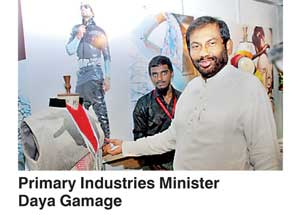Friday Jan 09, 2026
Friday Jan 09, 2026
Friday, 10 June 2016 00:03 - - {{hitsCtrl.values.hits}}
By Shehana Dain
The apparel industry has been urged to excel in speed and just in time delivery (JIT) as it can no longer rely on being a cheap labour destination to maintain a healthy position in the increasingly competitive global market.
Noting that the local apparel industry may have tasted success in the early years promoting low cost products, Joint Apparel Association Forum Secretary General Tuli Cooray yesterday said that the situation now compelled the industry to devise sharper marketing tools.
“The Local apparel industry is no longer a cheap labour cost driven industry. We will not be able to compete with countries in the region on the basis of low cost; it’s out of the equation. We have to think on different models of business. They started the journey in 2003 when they realised that the removal of the multilateral agreement with USA is going to create a paradigm shift. They decided to move forward introducing the concept of cost competiveness is the key and not the preferences. That is how this industry grew. Unfortunately the prevailing circumstances pushing us back as our costs are increasing at a rate.”
Observing a timely solution he said that it demands a major policy undertaking from the Government as well as the industry. “These costs inevitably will have to be borne. Thereby we only have two aspects to thrive on to take our business forward. The two elements are speed and just-in-time delivery because the quality and the partnership of the total supply chain solutions are no longer new things, everyone has to do that.”
Cooray who made these remarks at the Apparel Industry Suppliers Exhibition (AISEX) held after a hiatus of seven years said that in order to reduce already spiking costs electronic documentation of imports and exports are vital.
“One of the primary objectives that we expect from trade facilitation agreements is bringing our transaction costs down to the minimum by introducing electronic documentation for imports and exports. Today export documentation is 95% electronic and within two years we hope our import trading will be via electronic documentation. Unless we do that we will never be able to reduce our transaction costs and therefore we urge authorities direct their policies to achieve this,” he added.
The organisers have revived AISEX after a lapse of 7 years, mainly due to the recent visit by the EU delegation and the prospect of GSP plus. The exhibition will take place from the 9-11 June 2016 at the Sirimavo Bandaranaike Memorial Exhibition Centre. The event is organised by Lanka Exhibition & Conference Services Ltd and supported and endorsed by the Sri Lanka Apparel Institute (SLAI), Joint Apparel Association Forum (JAAF), Ministry of Industry & Commerce, Sri Lanka Institute of Textile and Apparel (SLITA) and National Chamber of Exporters (NCE).
AISEX aims to sharpen the manufacturers hunger for technological innovations in the apparel industry and to provide the garment industry with the complete solutions necessary to forge ahead.
-Pix by Shehan Gunasekara
In the backdrop of Sri Lanka’s continuous efforts to lift the GSP+ the Primary Industries Minister Daya Gamage said that there is hope for Sri Lanka to regain the much anticipated facility by end of this year.
Noting that if the apparel industry had not been deprived of the facility it would have been a $ 6 billion industry today the Minister said his ministry is exploring ways to double exports by 2020 via maximum utilisation of the country’s primary industries.
A top Lankan team headed by Department of Commerce (DOC) Director General Sonali Wijeratne was in Brussels last month for decisive discussions of the GSP+ application.
Moreover Gamage urged that while the industry innovates, increases production, looks for new markets provides better training and adopts better HR practices as it waits for good news from the European Union, it should in turn look at the garments value chain.
“Are there any gaps in this chain that we can exploit? What about investing more in the fabrics and handloom industry so that we can substitute imports of these primary products or looking for niche markets in what the European buyers are calling the sustainable garments area, or setting up accessory manufacturing plants locally,” he said.
Additionally Gamage highlighted that the local clothing industries internal value addition in the garment sector is estimated to be about 60%, thereby 40% still consists of raw material and services that are paid for by foreign exchange.
He advocated that the apparel sector is yet to explore some of the middle-income markets of Europe such as Spain, Portugal, and the Czech Republic.
“Recently, through the good offices of the Export Development Board, a Spanish apparel delegation was in town and I believe we have had some success with the largest clothing brand in the world today, Zara, which is a Spanish brand. We need to go explore these markets and the South American markets where conditions are now ripe for third country manufacturers to provide OEM (original equipment manufacturing) apparel.”